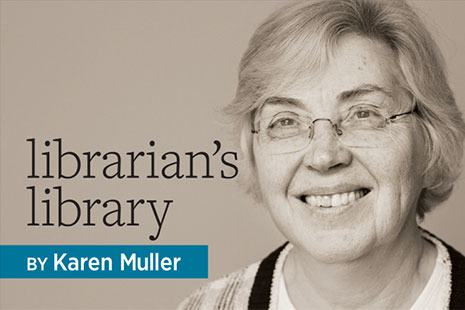
“The library is central to our free society. It is a critical element in the free exchange of information at the heart of our democracy.”—Vartan Gregorian, president, Carnegie Corporation of New York (In Praise of Libraries, 1989).
If libraries are a cornerstone of our democracy, librarians are the key to their riches. Librarians are also the key to enabling library users to unlock those riches on their own, whether through one-time bibliographic instruction or a more embedded form of instruction—information literacy.
At its January 2016 meeting, the board of directors of the Association of College and Research Libraries (ACRL) adopted the “Framework for Information Literacy for Higher Education.” It presents six interconnected core concepts, or frames, each central to information literacy. Two books amplify the document with practical applications; the four additional books are more tangential but nevertheless informed by the “Framework.”
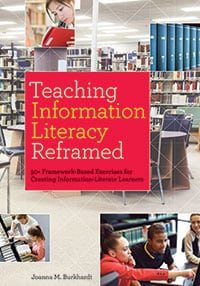 Teaching Information Literacy Reframed: 50+ Framework-Based Exercises for Creating Information-Literate Learners, by Joanna M. Burkhardt, works through each of the six frameworks, offering exercises that build expertise in each. For example, for the “Research as Inquiry” frame, which seeks to build expertise in asking the right questions to draw conclusions, there are exercises in narrowing options for a cellphone purchase, developing an outline, and understanding primary sources. They may not be radically different from past information literacy exercises, but their purpose and context have shifted. Indexed. ALA Neal-Schuman, 2016. 232 P., $58. PBK. 978-0-8389-1397-0.
Teaching Information Literacy Reframed: 50+ Framework-Based Exercises for Creating Information-Literate Learners, by Joanna M. Burkhardt, works through each of the six frameworks, offering exercises that build expertise in each. For example, for the “Research as Inquiry” frame, which seeks to build expertise in asking the right questions to draw conclusions, there are exercises in narrowing options for a cellphone purchase, developing an outline, and understanding primary sources. They may not be radically different from past information literacy exercises, but their purpose and context have shifted. Indexed. ALA Neal-Schuman, 2016. 232 P., $58. PBK. 978-0-8389-1397-0.
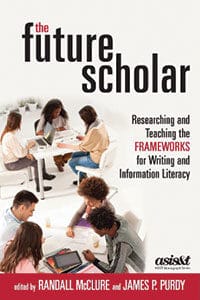 The Future Scholar: Researching and Teaching the Frameworks for Writing and Information Literacy, edited by Randall McClure and James P. Purdy, explores the impact of the ACRL “Framework” as well as the 2011 “Framework for Success in Postsecondary Writing,” authored in collaboration with the Council of Writing Program Administrators, the National Council of Teachers of English, and the National Writing Project. The editors posit that the documents together are a confluence of 21st-century skills. This book is the third in a series (with The New Digital Scholar and The Next Digital Scholar) addressing ways librarians can transition to practical implementation of the frameworks in order to help students develop habits and skills critical to success in the digital information economy. Information Today, 2016. 368 P. $59.50. 978-1-5738-7530-1. (Also available as an ebook.)
The Future Scholar: Researching and Teaching the Frameworks for Writing and Information Literacy, edited by Randall McClure and James P. Purdy, explores the impact of the ACRL “Framework” as well as the 2011 “Framework for Success in Postsecondary Writing,” authored in collaboration with the Council of Writing Program Administrators, the National Council of Teachers of English, and the National Writing Project. The editors posit that the documents together are a confluence of 21st-century skills. This book is the third in a series (with The New Digital Scholar and The Next Digital Scholar) addressing ways librarians can transition to practical implementation of the frameworks in order to help students develop habits and skills critical to success in the digital information economy. Information Today, 2016. 368 P. $59.50. 978-1-5738-7530-1. (Also available as an ebook.)
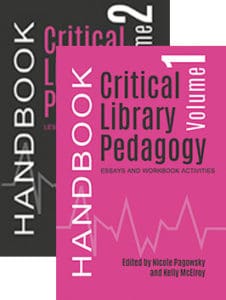 Pushing the boundaries of information literacy, Critical Library Pedagogy Handbook volumes one and two, edited by Nicole Pagowsky and Kelly McElroy, explore issues of “the theory and practice (or praxis) of inclusive and reflective teaching in order to broaden students’ understanding of power structures within the education system and in society.” In two volumes, “Essays and Workbook Activities” and “Lesson Plans,” the editors have assembled discussions and tools to help practitioners incorporate elements into teaching for social justice. ACRL, 2016. 552 P. $95. PBK. 978-0-8389-8917-3.
Pushing the boundaries of information literacy, Critical Library Pedagogy Handbook volumes one and two, edited by Nicole Pagowsky and Kelly McElroy, explore issues of “the theory and practice (or praxis) of inclusive and reflective teaching in order to broaden students’ understanding of power structures within the education system and in society.” In two volumes, “Essays and Workbook Activities” and “Lesson Plans,” the editors have assembled discussions and tools to help practitioners incorporate elements into teaching for social justice. ACRL, 2016. 552 P. $95. PBK. 978-0-8389-8917-3.
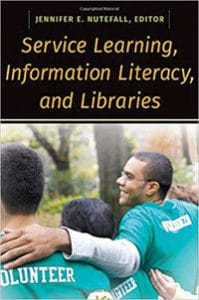 Service Learning, Information Literacy, and Libraries, edited by Jennifer E. Nutefall, takes information literacy in yet another direction: into the community. Service learning from the students’ standpoint is the opportunity to work in the community, practicing skills, developing a sense of social responsibility, and reflecting on the experience. The essays and case studies collected by Nutefall, some of which derive from a 2014 colloquium held at Santa Clara University, explain how information literacy practices can be used to enhance what students learn from the learning projects. For librarians, supporting service learning enables reaching into the community to demonstrate, perhaps to a new audience, the benefits of librarians’ skills. Libraries Unlimited, 2016. 155 P. $65. PBK. 978-1-4408-4091-3. (Also available as an ebook.)
Service Learning, Information Literacy, and Libraries, edited by Jennifer E. Nutefall, takes information literacy in yet another direction: into the community. Service learning from the students’ standpoint is the opportunity to work in the community, practicing skills, developing a sense of social responsibility, and reflecting on the experience. The essays and case studies collected by Nutefall, some of which derive from a 2014 colloquium held at Santa Clara University, explain how information literacy practices can be used to enhance what students learn from the learning projects. For librarians, supporting service learning enables reaching into the community to demonstrate, perhaps to a new audience, the benefits of librarians’ skills. Libraries Unlimited, 2016. 155 P. $65. PBK. 978-1-4408-4091-3. (Also available as an ebook.)
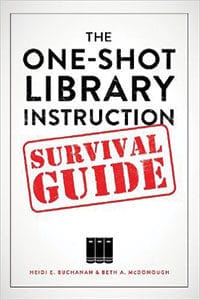 For a more immediate assist in developing a library instruction program, try the second edition of The One-Shot Library Instruction Survival Guide, by Heidi E. Buchanan and Beth A. McDonough. By “one-shot,” the authors are referring to a single presentation to a class, perhaps an orientation to library resources, rather than a course of study integrated into the curriculum. At first glance the “one-shot” might not fit into the ACRL “Framework,” but the authors integrate the concept with a practical twist. They look at collaborating with the faculty, classroom strategies, adapting to different environments, assessment, and managing one’s own success. ALA Editions, 2014. 136 P. $48. PBK. 978-0-8389-1215-7.
For a more immediate assist in developing a library instruction program, try the second edition of The One-Shot Library Instruction Survival Guide, by Heidi E. Buchanan and Beth A. McDonough. By “one-shot,” the authors are referring to a single presentation to a class, perhaps an orientation to library resources, rather than a course of study integrated into the curriculum. At first glance the “one-shot” might not fit into the ACRL “Framework,” but the authors integrate the concept with a practical twist. They look at collaborating with the faculty, classroom strategies, adapting to different environments, assessment, and managing one’s own success. ALA Editions, 2014. 136 P. $48. PBK. 978-0-8389-1215-7.
 Also of a more practical bent is Librarians and Instructional Designers: Collaboration and Innovation, by Joe Eshleman, Richard Moniz, Karen Mann, and Kristen Eshleman. We live, work, and learn in a networked world. Starting in the primary grades, learning is supported or enhanced by online programming. Sometimes it’s only assessment or an interactive bit of content; at other times it’s a whole course. The essays in this book explore how librarians designing instruction might benefit from collaborating with a campus instruction design team, as well as how to proceed if the team is absent. The authors compare the skill sets of the two groups of practitioners and review best practices, again informed by ACRL’s “Framework.” ALA Editions, 2016. 216 P. $65. PBK. 978-0-8389-1455-7.
Also of a more practical bent is Librarians and Instructional Designers: Collaboration and Innovation, by Joe Eshleman, Richard Moniz, Karen Mann, and Kristen Eshleman. We live, work, and learn in a networked world. Starting in the primary grades, learning is supported or enhanced by online programming. Sometimes it’s only assessment or an interactive bit of content; at other times it’s a whole course. The essays in this book explore how librarians designing instruction might benefit from collaborating with a campus instruction design team, as well as how to proceed if the team is absent. The authors compare the skill sets of the two groups of practitioners and review best practices, again informed by ACRL’s “Framework.” ALA Editions, 2016. 216 P. $65. PBK. 978-0-8389-1455-7.


